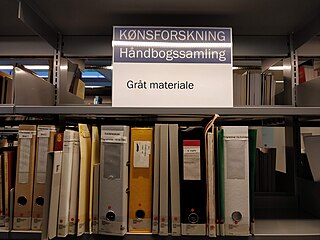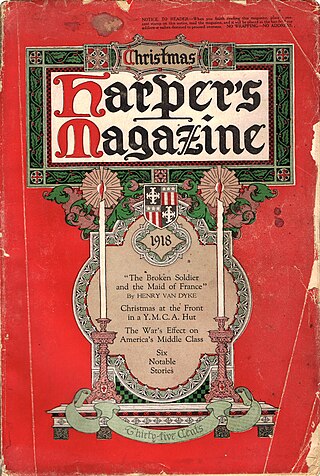
A copyright is a type of intellectual property that gives the creator of an original work, or another right holder, the exclusive and legally secured right to copy, distribute, adapt, display, and perform a creative work, usually for a limited time. The creative work may be in a literary, artistic, educational, or musical form. Copyright is intended to protect the original expression of an idea in the form of a creative work, but not the idea itself. A copyright is subject to limitations based on public interest considerations, such as the fair use doctrine in the United States.

A pamphlet is an unbound book. Pamphlets may consist of a single sheet of paper that is printed on both sides and folded in half, in thirds, or in fourths, called a leaflet or it may consist of a few pages that are folded in half and saddle stapled at the crease to make a simple book.
The first-sale doctrine is an American legal concept that limits the rights of an intellectual property owner to control resale of products embodying its intellectual property. The doctrine enables the distribution chain of copyrighted products, library lending, giving, video rentals and secondary markets for copyrighted works. In trademark law, this same doctrine enables reselling of trademarked products after the trademark holder puts the products on the market. In the case of patented products, the doctrine allows resale of patented products without any control from the patent holder. The first sale doctrine does not apply to patented processes, which are instead governed by the patent exhaustion doctrine.
Ripping is extracting all or parts of digital content from a container. Originally, it meant to rip music out of Commodore 64 games. Later, the term was used to mean to extract WAV or MP3 format files from digital audio CDs, but got applied as well to extract the contents of any media, including DVD and Blu-ray discs, and video game sprites.
A work of the United States government is defined by the United States copyright law, as "a work prepared by an officer or employee of the United States Government as part of that person's official duties". Under section 105 of the Copyright Act of 1976, such works are not entitled to domestic copyright protection under U.S. law and are therefore in the public domain.
The bibliographical definition of an edition is all copies of a book printed from substantially the same setting of type, including all minor typographical variants.

The United States No Electronic Theft Act (NET Act), a federal law passed in 1997, provides for criminal prosecution of individuals who engage in copyright infringement under certain circumstances, even when there is no monetary profit or commercial benefit from the infringement. Maximum penalties can be five years in prison with fines.

A disk magazine, colloquially known as a diskmag or diskzine, is a magazine that is distributed in electronic form to be read using computers. These had some popularity in the 1980s and 1990s as periodicals distributed on floppy disk, hence their name. The rise of the Internet in the late 1990s caused them to be superseded almost entirely by online publications, which are sometimes still called "diskmags" despite the lack of physical disks.
Music licensing is the licensed use of copyrighted music. Music licensing is intended to ensure that the owners of copyrights on musical works are compensated for certain uses of their work. A purchaser has limited rights to use the work without a separate agreement.

Grey literature is materials and research produced by organizations outside of the traditional commercial or academic publishing and distribution channels. Common grey literature publication types include reports, working papers, government documents, white papers and evaluations. Organizations that produce grey literature include government departments and agencies, civil society or non-governmental organizations, academic centres and departments, and private companies and consultants.
The Section 115 Reform Act of 2006 was a bill introduced June 8, 2006 in the 109th United States Congress by Howard Berman (California-D) and Lamar Smith (Texas-R) as part of. It is one of several recent attempts to modify Section 115 of the United States Copyright Act to accommodate digital delivery of musical works.

In United States copyright law, a copyright notice is a notice of statutorily prescribed form that informs users of the underlying claim to copyright ownership in a published work.

Free content, libre content, libre information, or free information is any kind of functional work, work of art, or other creative content that meets the definition of a free cultural work, meaning "works or expressions which can be freely studied, applied, copied and/or modified, by anyone, for any purpose."

The Copyright Act of 1976 is a United States copyright law and remains the primary basis of copyright law in the United States, as amended by several later enacted copyright provisions. The Act spells out the basic rights of copyright holders, codified the doctrine of "fair use", and for most new copyrights adopted a unitary term based on the date of the author's death rather than the prior scheme of fixed initial and renewal terms. It became Public Law number 94-553 on October 19, 1976 and went into effect on January 1, 1978.
The copyright law of the United States grants monopoly protection for "original works of authorship". With the stated purpose to promote art and culture, copyright law assigns a set of exclusive rights to authors: to make and sell copies of their works, to create derivative works, and to perform or display their works publicly. These exclusive rights are subject to a time and generally expire 70 years after the author's death or 95 years after publication. In the United States, works published before January 1, 1929, are in the public domain.
United States copyright registrations, renewals, and other catalog entries since 1978 are published online at the United States Copyright Office website. Entries prior to 1978 are not published in the online catalog. Copyright registrations and renewals after 1890 were formerly published in semi-annual softcover catalogs called The Catalog of Copyright Entries (CCE) or Copyright Catalog, or were published in microfiche.
Fixation in Canadian copyright law is a threshold consideration that must be used in copyright infringement cases by courts to determine if copyright actually exists.
Playboy Enterprises, Inc. v. Starware Publishing Corp. 900 F.Supp. 433 was a case heard before the United States District Court for the Southern District of Florida in May 1995. The case revolved around the subject of copyright infringement and exclusive rights in copyrighted works. Plaintiff Playboy Enterprises filed a motion for partial summary judgment of liability of copyright infringement against defendant Starware Publishing Corporation. Specifically, Playboy Enterprises ("PEI") argued that Starware's distribution of 53 of Playboy's images, taken from an online bulletin board, and then sold on a CD-ROM, infringed upon PEI's copyrights. The case affirmed that it was copyright infringement, granting Playboy Enterprises the partial summary judgment. Most importantly, the case established that "The copyright owner need not prove knowledge or intent on the part of the defendant to establish liability for direct copyright infringement."

Getaped.com, Inc. v. Cangemi is a 2002 case from the United States District Court for the Southern District of New York concerned with the issue of whether a copyrightable work made available over the internet could be considered published under the Copyright Act of 1976. Through analogy to traditional physical distribution, the court held that this indeed constituted publication.

A collective work in the copyright law of the United States is a work that contains the works of several authors assembled and published into a collective whole. The owner of the work has the property rights in the collective work, but the authors of the individual works may retain rights in their contributions. Electronic reproduction of the whole work is allowed, but electronic reproduction of the individual works on their own, outside the context of the work as a whole, may constitute an infringement of copyright.











